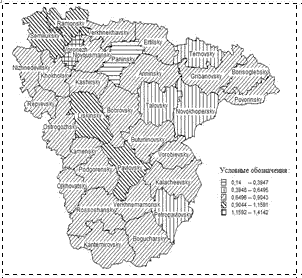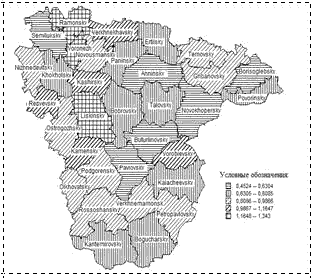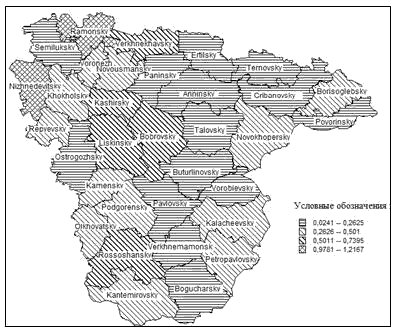Research Article: 2021 Vol: 25 Issue: 2S
Regional human capital: Problems of essence, structure and assessment (Voronezh region)
Natalia V. Yakovenko, Research Institute of Innovative Technologies and the Forestry Complex of the Voronezh State Forestry and Technologies named after G.F. Morozov
Roman V. Ten, Voronezh State Forestry and Technologies named after G.F. Morozov
Irina V. Safonova, Voronezh State University Forestry and Technologies named after G.F. Morozov
Igor V. Komov, Voronezh State University
Olga V. Didenko, Voronezh State University
Abstract
A characteristic trend of recent decades in the economy is a fundamental re-evaluation of productive forces, due to the global trend for innovative development. Gradually, the role and importance of material capital gives way to the palm of superiority to the abilities and skills of a person, his high professionalism and competence. The role of high-tech technologies, high-tech production, and the IT industry is steadily increasing. Today, the success of a company is primarily characterized not by the inventory of material goods, but by the possession of specific information that gives its owners enormous competitive advantages. In other words, the priority of the modern economy is to attract, accumulate, develop and retain human capital as the main factor of socio-economic growth and the basis of the state's competitiveness in the global economy. In this regard, the issue of objective assessment of human capital and further application of the results in practice is very relevant. The article uses the author's methodology to evaluate the human capital of the Voronezh region, which is one of the leading subjects of the Central Federal district in terms of socio-economic development. The proposed methodology for the study of human capital is defined and focused on solving a problem that differs from the generally accepted and widespread problems of quantifying the total human capital of a country or the value of the human capital of a firm (organization), as the value of certain intangible assets, expressed in monetary units. The use of the proposed methodological approach in practice will increase the validity of decisions and actions of authorities and management organizations that ensure the development of human capital in the region. This tool can be used by local authorities and state authorities, as well as other interested parties for the purpose of complex diagnostics of the human capital size of regions.
Keywords
Human Capital, Assessment, Voronezh Region, Social and Economic Development
Introduction
The current stage of Russian development is characterized by a decline in economic growth and a slowdown in overall development. It should be noted that since 2014, the Russian economy has faced a number of problems, both economic and political, that negatively affect the overall situation in the country.
The impact of the global economic system crisis is quite significant, and it should be noted that this crisis is, in fact, as noted by doctor of Economics V. Mau and colleagues, the imposition of several: structural, financial, and external shock (Aganbegyan, 2017). This fact dramatically complicates the overall situation, since the necessary socio-economic policy is multidirectional, and perhaps not always consistent.
Herewith the Russian economy is subject to external negative economic impact from a number of countries. This fact is reflected in a series of economic sanctions, which, being both financial and technological, slow down economic growth and exacerbate the consequences of the General crisis.
These negative factors formed the conditions for the transition of the Russian economy to a new stage of development, and in this regard, the issues of neoindustrialization have gained a second wind. Russia's transition to a new near-term neo-industrial stage of development involves taking into account the world's advanced scientific and technological progress in combination with the national historical specifics of the country, its economy and the features of its modern problems (Armstrong, 2010).
In the course of these processes, a significant part of material production, which accounts for up to half of the domestic GDP, will be transferred to new higher technologies, with a new material and technical base, including the latest generations of machinery and equipment. This, in turn, will require personnel with qualitatively updated knowledge and skills and significant investments in their training, as well as in General in the development of education, NIOKR (R & d), information and communication technologies, biotechnology and healthcare, which constitute the sphere of the so-called knowledge economy (Becker & Gary, 1964).
Thus, there is a change in the basis of competitiveness. If at earlier stages of the existence of socio-economic systems there were enough natural and physical capital for effective functioning, today this list is supplemented by a new type of capital–human. We are talking about the formation of a new economic category of capital–"human capital", which from secondary resources becomes the basis for optimal and efficient functioning of the economy at any hierarchical level.
Relevance of the Study
The relevance of the study of human capital in the system of economic factors growth is equally important both for post-industrial countries and for countries that have entered the path of market transformation. Human capital is the main value of modern society, as well as one of the fundamental factors of economic growth.
In this regard, the study of issues related to the formation and development of human capital, its impact on economic growth becomes particularly relevant.
Theoretical Base of the Study
Theoretical and methodological issues of studying the relationship between socio-economic development and human capital began to be actively studied in the second half of the twentieth century by such well-known scientists as G. Becker, T. Schultz, M. Friedman, M. Spence and others. The research of human capital as a factor in the development of the national economy is devoted to the work of E. Denison, J. Kendrick, P. Romer, R. Lucas. The modern period is characterized by a large number of studies devoted to a wide range of issues that consider human capital as a significant and independent factor of social production. Thus, the impact of human capital on the performance of the socio-economic system at the micro level was assessed in (Aganbegyan, 2017; Armstrong, 2010; Becker & Gary, 1964; Dolan & Lindsay, 1992; Grachev, 2018), and at the macro level-in (Koritsky, 2010; Kritsky, 1991; Munch & Skaksen, 2008; Shabunovoy, 2013; Schiller, 2008).
The efforts of such Russian scientists as L.B. Breslav, Yu. Vasilchik, E.S. Gvozdeva, A. I. Dobrynin, S.A. Dyatlov, V.A. Komarov, A.V. Koritskii, B.A. Korneychuk, Y.A. Korchagin, B.C. Lisovik, E.D. Tsyrenova, and other experts was formed the conceptual framework of the human capital theory as applied to Russian conditions and Russian territories.
Purpose of the Study
The purpose of the study is to evaluate the human capital of municipalities in the Voronezh region based on the analysis of existing theoretical and methodological approaches.
General Presentation of the Study
It is proposed to use a certain set of statistical indicators presented in official statistical collections for evaluation. This makes it possible to unify this methodological approach and, if necessary, evaluate and rank any number of regions in the presence of statistical information.
At the same time, it is necessary to evaluate human capital not only through quantitative characteristics, but also to pay attention to the conditions of reproduction. Note that due to the shift of the center of gravity to the person (employee) in terms of forming the competitiveness of territories, it becomes important to evaluate the quantitative and qualitative characteristics of the category of human capital in comparison with the results of its implementation in the region.
A more complete implementation of the region's human capital contributes to increasing the competitiveness of the territory and thereby increasing economic well-being. Accordingly, it is also necessary to evaluate criteria that reflect the level of economic development of the subject.
Thus, in our opinion, it is advisable to evaluate the human capital of the region according to three criteria:
* quantitative (R1)-reflects the overall level of human capital in the region;
* quality (R2)-conditions for the reproduction of human capital;
* resultant (R3)–general economic assessment of territory development [Grachev].
In connection with the above logic, it is proposed to create a list of indicators for each criterion (table 1).
| Table 1 Indicators Of A Comprehensive Assessment Of The Region's Human Capital |
||
|---|---|---|
| Criterion | Indicator | Economic content of the indicator [14] |
| Quantitative (R1) | Number of the labor force | Persons aged 15-72 who are considered employed or unemployed during the period under review (the week under review). |
| The number of employees engaged in research and development. | A group of people whose creative activities, carried out on a systematic basis, are aimed at increasing and searching for new areas of application of knowledge, as well as engaged in providing direct services related to the implementation of research and development. | |
| Unemployment rate | the ratio of the number of unemployed in a certain age group to the number of workers in the corresponding age group, as a percentage | |
| Qualitative (R2) | Среднедушевые денежные доходы населения | Average per Capita monetary income of the population the result of dividing the volume of monetary income by 12 and by the average annual population |
| The average monthly nominal accrued salary | The result of dividing the employee's accrued salary fund by the average number of employees and by 12 months | |
| The average size of the appointed pensions | The result of dividing the total amount of assigned pensions by the pensioners number | |
| Resultant (R3) | Gross Regional Product (GRP) per person | The result of dividing the GRP value by the population of the region |
| Fund-building capacity | the ratio of the average annual value of fixed assets to the average annual number of employees | |
It should be noted that in order to bring different time indicators to a comparable form, normalization procedure was carried out. Normalization is the transformation of formal parameters of an object, expressed in various units, to a dimensionless form for the purpose of their comparison and comparative evaluation.
The indicators presented in table 1 are characterized by different directions, so, for example, the optimality of indicators in a data series is directly proportional to their value. However, the unemployment rate is the opposite for a more favorable situation in the region, a minimum value of this indicator is necessary.
This aspect was taken into account when normalizing the data. For the first group, normalization was performed using the formula (1), for the second group – using the formula (2).

хact – the actual value of the normalized indicator;
хmin – the minimum value of the indicator in the aggregate of the analyzed regions for a certain period;
хmax – the maximum value of the indicator in the aggregate of the analyzed regions for a certain period.
Further, for the purpose of a comprehensive assessment of the criteria, the aggregate value for each group was calculated. This indicator is determined by the formula (3).

Analyzing the data (Fig. 1-3), we can see that throughout the period under review, Voronezh is the undisputed leader in all parameters. At the same time, its indicators are several times higher than those of other municipalities. This fact can be explained by the existing differentiation of territories according to the initial indicators of development, primarily with regard to quantitative criteria.
All municipalities were divided into 5 groups.
The subjects of group 1 are characterized by the maximum (the most optimal) values for all three groups of criteria. Other subjects have lower parameter values, so it becomes possible to characterize them as territories with a lower amount of human capital. Thus, the lag in quantitative and qualitative criteria is expressed in the lower values of the resulting indicators (GRP and capital strength). In General, it can be noted that the most "problematic" zone for most municipal districts remains the R1 criterion, i.e., a group of quantitative indicators. Despite the observed growth of the total labour force and improvement of reproduction conditions of human capital (criterion R2), in most regions there is a decrease in the number of personnel involved in research and using information and communication technologies and the growth in unemployment, which negatively affects the resulting indicators of development of territories.
Conclusion
Thus, based on a comprehensive assessment of the size of the human capital regions, based on several criteria, complex indicators have been formed that allow us to assess the current state of territories, rank them, and identify problem areas that hinder the socio-economic development of subjects in terms of the formation and use of human capital. A universal tool has been developed that allows us to estimate the value of the region's human capital on the basis of available statistical information by evaluating its quantitative indicators, conditions for its reproduction, and the resulting indicators of territorial development. The conclusion is made about the differentiation of municipalities in the Voronezh region according to the criteria for evaluating human capital.
Acknowledgement
The reported study was funded by RFBR, project number 19-29-07400-mk
The reported study was funded by RFBR, project number 19-35-90021
References
- Aganbegyan, A.G. (2017). Investments in fixed assets and investments in human capital–two interconnected sources of socio-economic growth. Problems of forecasting, 4, 17–20.
- Armstrong, M. (2010). The practice of human resources management, (10th edition). St. Petersburg: Peter, 848.
- Becker, B., & Gary, S. (1964). Human capital. Columbia University Press, 320.
- Dolan, E., & Lindsay J. (1992). Market: Microeconomic model. SPb, 477.
- Grachev, S.A. (2018). The value of human capital of the regions on the basis of multi-criteria approach. Management Issues, 2, 46-53.
- Koritsky A.V. (2010). Human capital as a factor of economic growth of Russian regions. Novosibirsk: publishing house of the Siberian University of consumer cooperation, 368.
- Kritsky M.M. (1991). Human capital. St. Petersburg: Len. Univ, 15.
- Munch, J., & Skaksen, J. (2008). Human capital and wages in exporting firms. Journal of International Economics, 75, 363–372.
- Shabunovoy, A.A. (2013). Problems of the effectiveness of public administration. Human capital of territories: problems of formation and use: Monograph. Institute for Socio-Economic Development of erritories of the Russian Academy of Sciences, 184.
- Schiller, T. (2008). Human capital and higher education: How does our region fare? Business Review.
- Shingarov, G.H. (2012). Human capital, human potential and social capital. Bulletin of the Moscow State Academy of Business Administration. Series: The Economy, 4, 49–58.
- Smith, A. (1962). A study on the nature and causes of the wealth of peoples. Moscow: Sotsgiz, 492.
- Soboleva, I.V. (2009). Paradoxes of measuring human capital. Issues of Economics, 9, 51–69.
- Sysoev, S.A. (2018). Institutional paradoxes of investments in human capital under the conditions of transformational economy. Laboratory of New Political Economy.
- The Russian economy. (2016). Trends and prospects. Moscow: Institute Gaidar, 520.
- Tnurow, L. (1970). Investment in human capital. Belmont, 190.
- Yakovenko, N.V., Komov, I.V., & Didenko, O.V. (2017). Strategic planning as a tool for managing territorial development: theoretical aspects. Monography: Management of socio-economic systems: Theory, methodology, practices. Penza: MCSC "Science and Enlightenment", 130.
- Yakovenko, N.V., & Porosenkov, Y.V. (2013). Theoretical approaches to the study of the depressive regions of Russia. Bulletin of Voronezh State University. Series: Geography, Geoecology, 10-21.
- Yakovenkо, N.V., Didenko, O.V., & Safonova, I.V. (2019). Socio-ecological well-being of the population (the regions of the central federal district are Example). IOP Conference Series: Earth and Environmental Science. 272(3), 1-8.
- Zyabluk, R.T., & Titova, N.I. (2016). Non-industrialization of the Russian economy: the need and opportunity (a review of the materials of the round table on the neoindustrialization of the Russian economy). Bulletin of the Moscow University. Series 6: The Economy, 2, 119–135.
- Yakovenko, N.V. (2007). "Quality of life of the population" as a scientific category of demography. Ecology of Urban Areas, 1, 41-46.


